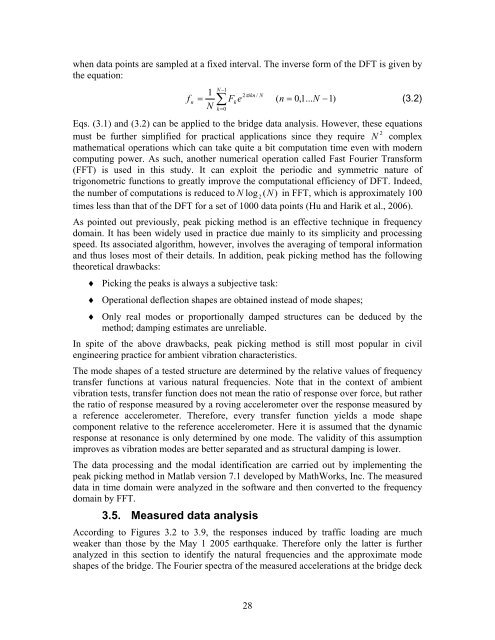Assessment of the Bill Emerson Memorial Bridge - FTP Directory ...
Assessment of the Bill Emerson Memorial Bridge - FTP Directory ...
Assessment of the Bill Emerson Memorial Bridge - FTP Directory ...
- No tags were found...
You also want an ePaper? Increase the reach of your titles
YUMPU automatically turns print PDFs into web optimized ePapers that Google loves.
when data points are sampled at a fixed interval. The inverse form <strong>of</strong> <strong>the</strong> DFT is given by<strong>the</strong> equation:1 N −12 ikn / Nfn= ∑ F ke π (n = 0,1...N −1) (3.2)N k =0Eqs. (3.1) and (3.2) can be applied to <strong>the</strong> bridge data analysis. However, <strong>the</strong>se equationsmust be fur<strong>the</strong>r simplified for practical applications since <strong>the</strong>y require N 2 complexma<strong>the</strong>matical operations which can take quite a bit computation time even with moderncomputing power. As such, ano<strong>the</strong>r numerical operation called Fast Fourier Transform(FFT) is used in this study. It can exploit <strong>the</strong> periodic and symmetric nature <strong>of</strong>trigonometric functions to greatly improve <strong>the</strong> computational efficiency <strong>of</strong> DFT. Indeed,<strong>the</strong> number <strong>of</strong> computations is reduced to N log 2(N) in FFT, which is approximately 100times less than that <strong>of</strong> <strong>the</strong> DFT for a set <strong>of</strong> 1000 data points (Hu and Harik et al., 2006).As pointed out previously, peak picking method is an effective technique in frequencydomain. It has been widely used in practice due mainly to its simplicity and processingspeed. Its associated algorithm, however, involves <strong>the</strong> averaging <strong>of</strong> temporal informationand thus loses most <strong>of</strong> <strong>the</strong>ir details. In addition, peak picking method has <strong>the</strong> following<strong>the</strong>oretical drawbacks:♦ Picking <strong>the</strong> peaks is always a subjective task:♦ Operational deflection shapes are obtained instead <strong>of</strong> mode shapes;♦ Only real modes or proportionally damped structures can be deduced by <strong>the</strong>method; damping estimates are unreliable.In spite <strong>of</strong> <strong>the</strong> above drawbacks, peak picking method is still most popular in civilengineering practice for ambient vibration characteristics.The mode shapes <strong>of</strong> a tested structure are determined by <strong>the</strong> relative values <strong>of</strong> frequencytransfer functions at various natural frequencies. Note that in <strong>the</strong> context <strong>of</strong> ambientvibration tests, transfer function does not mean <strong>the</strong> ratio <strong>of</strong> response over force, but ra<strong>the</strong>r<strong>the</strong> ratio <strong>of</strong> response measured by a roving accelerometer over <strong>the</strong> response measured bya reference accelerometer. Therefore, every transfer function yields a mode shapecomponent relative to <strong>the</strong> reference accelerometer. Here it is assumed that <strong>the</strong> dynamicresponse at resonance is only determined by one mode. The validity <strong>of</strong> this assumptionimproves as vibration modes are better separated and as structural damping is lower.The data processing and <strong>the</strong> modal identification are carried out by implementing <strong>the</strong>peak picking method in Matlab version 7.1 developed by MathWorks, Inc. The measureddata in time domain were analyzed in <strong>the</strong> s<strong>of</strong>tware and <strong>the</strong>n converted to <strong>the</strong> frequencydomain by FFT.3.5. Measured data analysisAccording to Figures 3.2 to 3.9, <strong>the</strong> responses induced by traffic loading are muchweaker than those by <strong>the</strong> May 1 2005 earthquake. Therefore only <strong>the</strong> latter is fur<strong>the</strong>ranalyzed in this section to identify <strong>the</strong> natural frequencies and <strong>the</strong> approximate modeshapes <strong>of</strong> <strong>the</strong> bridge. The Fourier spectra <strong>of</strong> <strong>the</strong> measured accelerations at <strong>the</strong> bridge deck28
















